Protective grounding It is used to protect a person from electric shock when touched not only to the current elements, but also a housing or other parts of electrical installations. This can occur in the event of a short circuit when the metal elements of the electrical installation are 220V, and even the body of any household appliance may be fatal for a person. The main principle of grounding is to ensure the contact of the parts that do not carry the current, with the land or similar to it by the properties of materials (for example, by stone coal or other equivalents according to GOST), so that the current potential is reduced to a safe level. In order for it to work, in the ground it is necessary to place a metal part - the grounding agent, and the wire must be conducted to it connecting the earthing directly with the electrical installation itself.
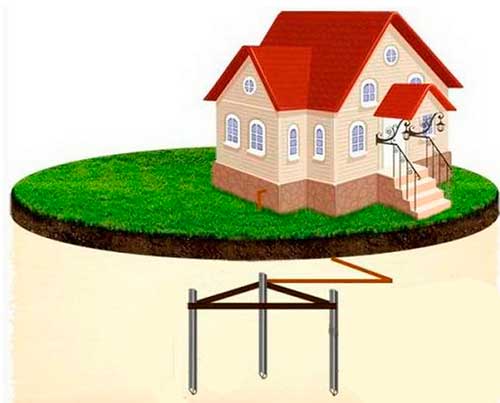
In addition, there is another ground function - it helps to reduce the level of interference. The principle of this action lies in the fact that the high-frequency current goes into the ground, thereby the device (example is a powerful electric motor) does not create interference with the surrounding electrical installations. If the grounding action is aimed at improving the quality of electrical equipment, to increase its terms of operation, then a similar system is called a working ground. Work grounding according to GOST requirements is applied on transformers and electric generators, large power plantsIt also includes grounding of bulky and lightning lighters.
There are two types of grounding:
- natural;
- artificial.
To this or that species can be attributed to grounding of the device by the nature of its earthing. Natural grounders include familiar underground metal structures that perform a double function on demand. It may be ordinary water pipes (Unless they transport combustible fluids or gases), metal structures that are the foundation of the building (for example, piles), etc. All other grounding methods belong to artificial (installation of special metal rods, etc.). It is worth noting that the installation of a protective earth can only be carried out by an electrician specialist who will take into account not only the necessary voltage parameters, but also the resistance of the soils, and other important factors.
When electricity comes into the ground from the earthing, a small amount of current spreads around it and can harm the person to be nearby. This circle around the metal earthing is called the lesion radius. Usually the current current standing on Earth does not bring high damage (it affects the level of soil resistance and the initial current of the current), the exception is the case when a person turns out to be near the thunder.
In the event that a person turned out to be directly within the radius of the defeat electric current, the voltage of which is not very large, it follows as smaller chambers as small as possible, preferably without taking legs from the ground. This is called the principle of step tension. Thus, the action on the human body will be the smallest.
There are two types of grounding devices relative to their location relative to the electrical appliance itself:
- remote;
- contour.
The peculiarity of the remote grounding is that it is outside the site, on which the electrical installation itself is located. The contour grounding passes through the perimeter of the electrical installation zone (i.e., according to the contour), and maybe inside. The action of the earthing agents themselves does not change from this, they still provide a high level of security if constructed according to the requirements.
In order to calculate how the number of earthing people need you and at what distance to arrange them, you will have to make a protective grounding. The resistance of the spreading of the current from 1 grounding element of the metal rod is calculated by such a formula:

For calculations for this formula, you need to know the length and diameter of the earthing rod, resistivity Soil (which can be found on the table, knowing which land you will immerse the entrancers) and the distance from the ground from the middle of the rod.
This example clearly shows how to determine how many rods will need to be used to ground the electrical appliance. The resulting value must be rounded to the nearest whole to the most side.
There is also a diagram for which the current resistance is calculated for horizontal earthing. To do this, you need to know the length and width of the metal structures themselves, the seasonality coefficient and the demand ratio. If the horizontal rods are located along the contour, then each length is equal to the distance between them L \u003d a.
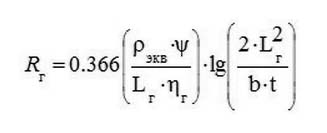
If you yourself decided to determine the contour for the future grounding, the contours of geometric figures are best suited. Depending on the site that you have, you can select the circuit of the square, rectangle or straight line. But the most optimal form for the perimeter of the ground is a triangle. For a private house, an equilateral triangle is an extremely comfortable contour, because it allows the current evenly to spread in all directions and not shielded.
In order to accurately find out the resistance of the contour of your grounding mechanism, the easiest to use a special electrical appliance. It shows the level of not only contour resistance, but also will help without reference information Learn the soil resistance during homemade grounding in a private area.
Exchange Groove Standards

Article GOST 12.1.030-81 clearly regulates the rules for compliance with electrical safety in networks with different voltage (up to 1000 V and more than 1000 V), with constant or alternating current. It is recommended to comply with the principle of security absolutely for any electrical installations, they must all be either grounded or reassembled. According to the requirements of GOST, first of all, natural underground structures should be earthed, but it is necessary to control that they are durable, chemically and thermally stable, could provide the necessary protection at any time of the year. All portable and manual entry settings should also be controlled, and undergo the necessary check.
For networks in which the voltage reaches more than 1000 V isolated neutral, the resistance of the grounding device according to GOST cannot be more than R \u003d 250 / L where L - maximum power Current. If the resistivity of the Earth is greater than 500 ohms, then the formula introduces an additional increase in the coefficient.
Based on the "Rules for the technical operation of electrical installations of consumers" and "Safety Rules for Consumer Electrical Installations" recorded in the requirements of the GOST, all grounding devices pass the control check during primary installation, as well as during operation after a certain period of time to make sure that they Complies with safety standards.
Grounding and zero
Protective grounding and stress in electrical installations are similar processes that carry the same function in themselves, but are carried out slightly differently. Both of these schemes are used to secure the use of electrical appliances from lesion. When grounding, the wire from the installation should be connected to the Earth, and when replacing - with zero wire.
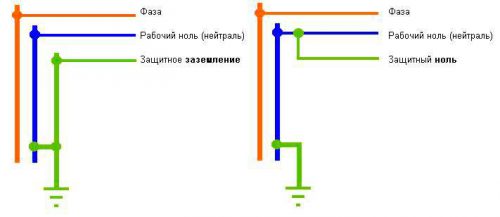
Zero conductors can serve:
- Natural designs - pipelines, metal piles, production steel elements.
- Separate lived from a stranded cable or wire.
- Special separate conductor.
- Aluminum cable shell.
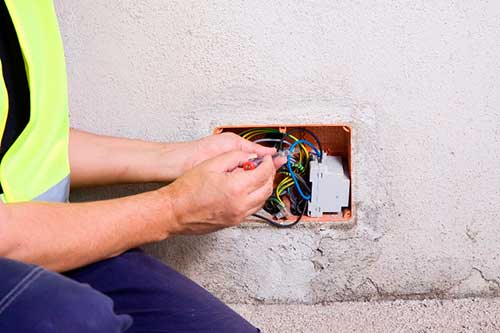
Even in a conventional residential building there are a number of installations that necessarily require grounding. These include:
- electrical switch;
- electrical cabinets;
- metal housings of household electrical appliances;
- metal phuspecus electrical equipment.
According to GOST in all residential buildings The protective ground ensures the safety of the main electrical installations, and also, of course, has its own earthing source of external food source at home - a transformer. These requirements are also presented to all new buildings that cannot be commissioned without checking the level of electrical safety.
Household appliances that are made according to the modern pattern, there are already three wiring in the fork, one of which is associated directly with the case. The same third posting is also provided in sockets. Thanks to this, an ordinary person should not worry about safety when connecting small electrical appliances, they are joined without interference from the outside and short closure Do not carry threats. Large household electrical appliances like washing machines or electrical heaters are recommended to be installed by a specialist who is familiar with the requirements for GOST protective grounding or a rejection.
There are two types of networks that can be found in modern houses. This is single-phase and three-phase. Each of them has 1 zero protective conductor, 1 working zero and 1 or 3, respectively, phase wires. In modern buildings, there is already a zero, or grounding of all the main electrical installations, but in the old residential buildings it is not stipulated, therefore, residents need to be borne by this process.
How to independently make grounding in the apartment (house)
If you live in old builder Or want to secure your a private house Or cottage, consider as an alternative to several grounding schemes.
One way is to use undergoing instead of grounding. To do this, you must attach the housing to neutral (zero conductor). According to this principle, with a sharp appearance of voltage on the case there will be a short circuit of zero and phases, due to which the voltage will increase greatly, and the fuses will work (protection machines).
A similar scheme can be dangerous if it does not do a professional that can elementary to confuse the phase with zero. Also when the zero wire breaks, all electrical appliances housings will be under voltage, which will make them potentially dangerous.
Also, if you use three-phase electrical appliances that do not need a zero conductor, you can apply a diagram called in international terminology as IT. Its feature is that each electrical appliance should have his own earthing. Alternative to it are standard TT and TN-S-S schemes. Their mechanism is registered according to the guests, which can be found on the Internet or special literature.
Portable protective grounding designs
In many situations, it is necessary to adhere to additional security when conducting work next to electrical installations. Despite the fact that the overall voltage can be disabled, it is desirable to ground separate designs if you need to work directly with them. Stationary protective grounding device can fail, and the voltage will occur in the items that the wizard works with. To this not happen, mobile portable entries are used. They can range suddenly emerging tension, thereby connecting people working on separate elements of electrical installations. Such electrical safety must be observed at all major industrial enterprises, factories, power plants.
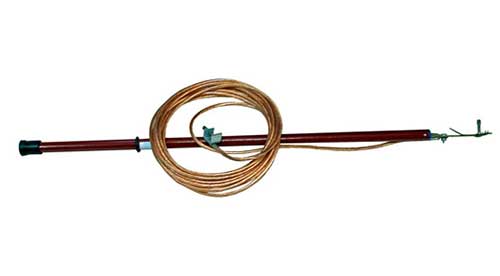
Portable grounding installations are found several species depending on the form and purpose:
- rod portable structures;
- breaktar portable structures;
- roda portable structures with metal links.
Most often, portable protective mechanisms are used to carry out repair and installation works on air lines or distribution electrical installations. The principle of their action lies in the fact that they consist of three main elements: conductive parts, contact and actual insulating element (there may be several).
Very high demands apply to such portable designs, because the life of a person directly depends on their quality. First, they should be strong to climbs, which are attached to wires or contacts, did not score and do not break from the manipulations of electrical installations. Secondly, all elements of the portable installation must be made of highly resistant materials that do not fall from voltage with a short circuit.
It can be concluded that for the entire electrical equipment (from large-scale, feeding whole areas with electricity, to small household appliances) use systems of protective grounding or reassembly. The appointment of protective grounding is to reduce the risk of lesion of people with a current to a minimum or reduce the power of the voltage to a safe level. If all the basic requirements for the installation of these structures are observed, then the person does not threaten to be affected by high voltage with a short circuit, current leakage or electrical wiring.
One of the most effective measures to protect the destruction of damage to the current in the event of a touch of electrical installations in the metal inadlining parts, is a protective ground. The protective ground is called a deliberate electrical connection with the Earth or its equivalent of metal inadvertent parts, which may be energized due to the closure on the body or for other reasons. Circuit on the body is possible as a result of damage to the insulation, tancing the current-carrying part of the machine body, the incidence of the wire is under voltage, to the inactive metal parts, etc.
The principle of the protective grounding is as follows. Suppose that the case of the current collector is not grounded and it is under the voltage of the closed phase. The touch of a person to such a body is tantamount to direct contact with the phase wire. The resistance of a person will be included between the hull and the ground. Through a person will pass a current that may be dangerous for his life.
To reduce this danger and reduce the value of the current passing through the human body to a safe value, the casing of the current collector is grounded, as a result of which a chain is created, the human shunting body is created providing the path with low resistance to the current-visiting. At the same time, most of the current of the closed phase flows through the grounding device, bypassing the human body. The voltage under which the person will turn out to be touched to the body, i.e. Touch voltage, it will be small and significantly less than phase. If we consider that the resistance of the protective ground has a value of 4 ohms and the circuit voltage is 380 V, then the current through the human body in the presence of a protective ground will be about 1 mA and the tension voltage of about 1 B, which does not represent.
The protective ground should be applied in three-phase three-wire networks with an isolated up to 1000V voltage and in networks with a voltage above 1000V with any neutral mode. Grounding of the inadvertent parts of electrical installations must be performed:
in rooms with increased danger, especially dangerous and in external installations - at rated voltages above 42V, but below 380V alternating current and above, but below 440 in DC;
in rooms without increased danger-at voltages 380V and above AC and 440V and above DC;
in explosive rooms, with all voltage values \u200b\u200bof alternating and constant currents.
The grounding is subject to housing of electrical machines, transformers and devices, firebread frames and cabinets, metal housings of lighting and cable shells, steel tubes Electric wiring and other metal structures related to the installation and fencing of equipment, metal housings of mobile and portable current applicants, etc.
Do not ground the body of electrical equipment installed on grounded metal structures and with reliable electrical contact with it with reference surfaces; Lighting fittings when installing it on wooden structures; Cases of electrical receivers with double insulation; Cases of electrical measuring devices, relays installed on shields, shields and cabinets.
Grounding device. The grounding device is called the totality of the grounding and grounding conductors. The earthing is a conductor (electrode) or a set of metallically interconnected conductor (electrodes) in contact with the Earth. Ground conductor - Explorer connecting grounded parts with a grounding. By the location of the earthing agents relative to the grounded grounding cases are divided into remote and contour. Grounding electrical equipment at stations is usually remote. In the device of the protective ground, the natural entries should be used primarily: water and other metal pipelines are laid and in contact with it, with the exception of pipelines of combustible liquids, flammable or explosive gases and mixtures.
If there are no natural earthingers or they do not meet the requirements of the Pue, then it is necessary to arrange artificial entries. As an artificial entrancers, vertically scored in the ground are used: steel rods with a diameter of 10-16 mm and a length of 4.5 - 5 m, angular steel with a shelf width from 40x40 to 60x6 mm and a thickness of at least 4 mm, steel pipes with a diameter of 25-30 mm With a wall thickness of at least 3.5 mm. The length of the vertical entrancers from the corner steel or pipes is 2.5-3 m, the entrancers are immersed (clogged) into the ground in a specially prepared trench. To connect the vertical electrodes between themselves and as an independent horizontal electrode, strip steel with a cross section of at least 48 mm 2 and a thickness of at least 4 mm or steel round cross section with a diameter of at least 10 mm. Artificial earthing and connecting conductors should not be painted. Do not have (use) earthing in places where the lands are dry under the influence of pipelines.
In the buildings, the grounding highway is laid, which connects with earthing agents at least in two places. As grounding protective conductors (highways and branches), the conductors specifically provided for this purpose must be used; metal structures of buildings (farms, columns, etc.); Metal production designs (crane pathways, distribution device frames, elevator shafts, etc.); Steel pipes of wiring; Metal stationary discovered pipelines of all appointments, except for pipelines of combustible and explosive substances and mixtures, sewage and central heating, etc. These conductors, structures and other elements should satisfy PUE requirements, ensure the continuity of the electrical circuit throughout the use.
Fig. 5. Scheme of protective grounding
u - Touch voltage, R - Resistance to grounding arrangements
With the help of creating an electrical connection of metal structures of industrial and household equipment with the Earth, safety increases in the process of its operation. Such a method is used to prevent human damage to electric shock when emergency situations occur.
Figure below shows the basic principles of the functioning of the protective system. Even with the use of high-quality automatic devices, the speed of their disconnection will be insufficient to completely eliminate the possibility of human damage to electric shock. If there is grounding, a chain with less resistance will be formed. This will reduce the harmful effects on the human body to a safe level.
Protective Grounding - Required Safety Element Preventing Electrotok
Principle of operation
It is usually installed for protection when a short circuit occurs. If the phase conductor is disconnected and touches the metal chassis, the body will be under voltage.
Properly created protective grounding forms an electrical circuit having a low resistance. It is this way that is the most favorable for electric current, therefore the accidental touch of a person to the housing will not be dangerous (Fig. Above).
It should be noted that such a device will simultaneously perform several important functions:
- It will provide protection and in the case when potentially dangerous tension On the housing is not formed by a short circuit, and induction currents. Such situations are possible in high-voltage installations and where the effect of microwave radiation is permissible.
- Using plug-free neutral And some other connection schemes in the power circuit with a short circuit there will be long and large pulses on the amplitude, sufficient to trigger the automata, disconnecting the voltage.
- If the grounded equipment is subjected to lightning, then such a conductor will provide certain protection against damage.
According to this formula, the resistance of the protective chain conductor between the main bus and the distribution panel is calculated: 50 x OCP / NN. SFR - resistance in the zero phase circuit; NN - voltage nominal in volts.
In order not to be mistaken with the terminology, it is necessary to understand the actual meaning of the following names:
- The worker is called grounding that performs the functions of the second conductor. It is used for electrical power supply installations, solving other tasks.
- The above-mentioned lightning protection is not targeted. To ensure safety during thunderstorms, specially intended for this device are used. They are calculated on the relatively large values \u200b\u200bof currents and stresses.
Connection schemes
To select the optimal option, you need to know for what purpose the protective ground is used in a particular case. The following are different systems, their features, advantages and disadvantages.
Type TN, with deaf grounded neutral. This scheme connects industrial and domestic equipment that operates in networks with voltage up to and above 1000 V. The neutral of the generator (transformer) of the power supply is connected to the earthing. Consumer devices, or rather the housing, screens, chassis, connect to the general conductor.
If a electrical circuit Created in accordance with international standards, then the following can be understood as inscriptions. The Latin letter "N" denote the "zero" conductor, which is used for the equipment. It is also called functional. "PE" is a conductor used to create a protective chain. Letters "Pen" denote a conductor designed to solve functional and protective tasks.
Most often use the following schemes. Their names are characterized by the letter, which is added through the hyphen to "TN".
Connection schemes
| System | Principle of operation | Benefits, Disadvantages, Features |
|---|---|---|
| C. | In the system "C", the conductor performs workers and protective functions at the same time. As an example, it is possible to recall the typical three-phase power supply with a deaf-free neutral, which is zero wire. | This scheme is relatively simple and economical. Consumer device housings are connected directly to neutral. The disadvantage is the loss of protective properties if electrical circuit Ripped. Such damage cannot be excluded when an emergency increase in current, heating and destruction of the conductor. In such a situation, a dangerous voltage appears on the case. When using such systems, automata, which must quickly and reliably disconnect the supply voltage are particularly carefully selected. |
| S. | This scheme uses two separate zero conductor, working and protective. | Several conductors increase the cost of the system, but significantly increase the reliability of protection. |
| C-S. | This is a combined system. The generating source is connected to a deaf-market neutral. Only four conductor (three-phase food) go to the consumer. In the property of real estate, a protective conductor "PE" is added. | Low compared with the previous option, the cost is accompanied by less reliability. If the conductor is damaged on the site to the object (or to "PE), the protective functions will be lost. In accordance with current standards, when using such systems, it is required to prevent mechanical damage to the relevant conductors. |
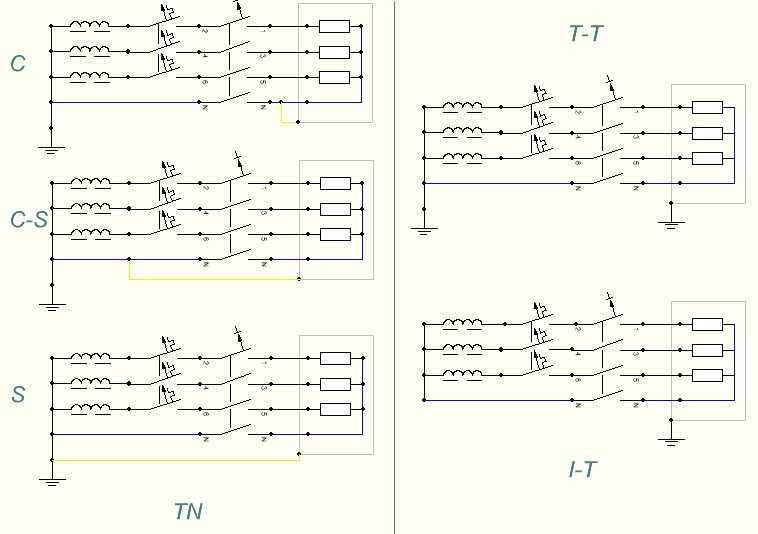
The most commonly used connection schemes
Enough high risks arise when used air lines Power transmission. They may be damaged by hurricane, other negative external influences. To ensure a high level of security, use the TT scheme.
Plug-free neutral is connected to the generator. Energy transmission is carried out in four wires. The consumer is installed autonomous system Grounding to which equipment housings are connected.
Views
To resist the minimum, it is desirable to reduce the length of the protective conductor. This is provided by creating a grounding circuit around the perimeter of the object.
Remote systems are used when equipped with installations that work with a supply voltage to 1 000 V.
Eggs are also divided into artificial and natural. This distribution in groups is conditionally, since in both cases the metal parts of the structures are used in the land:
- In the first - they are created specifically, for the grounding system. This approach allows you to accurately calculate the resistance, the size of individual parts, other important parameters.
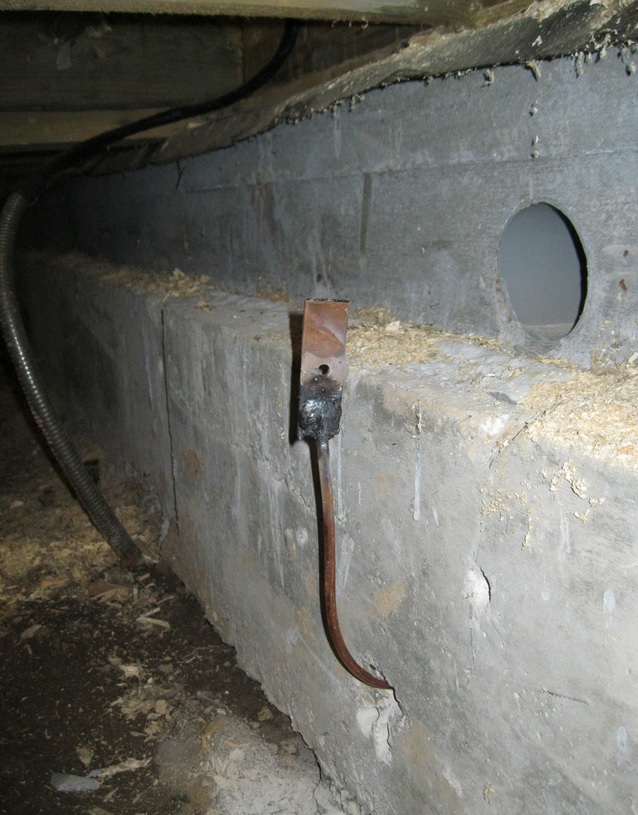
Natural earthing - metal part of the structure in the ground
- The second option provides connecting to the metal parts of the building structure, fittings of the foundation units. It is more economical, as some ready-made details are used to protect. However, it must be borne in mind that the installation of the corresponding lines will need to connect the equipment, which will have resistance defined standards. The disadvantage is the relative availability of conventional personnel.
For grounding, conductors from copper, black and galvanized steel are used. Sections and other product characteristics are selected taking into account the electrical parameters of the installation and the conditions of its operation.
In particular, matters the level of humidity. When calculating, the resistivity and other fittings are checked.

Soils in which grounding devices are installed
Video about grounding
How to pick up and make a protective ground in the house, tells in this video.
This article discusses the principle of operation of protective grounding and the main parameters of the relevant engineering systems. To accurately comply with the current norms, it is necessary to study the "Rules of the Electrical Installation Device", approved by the Ministry of Energy of Russia in order from 08. 07. 2002. The grounding requirements are set forth in Ch.1. 7 of this document.
The organization of a reliable system of protective electrical safety is one of the main conditions that cause damage to users of electrical installations. It will protect not only a person, but also to the instruments. A competently calculated and mounted protective ground will prevent the negative impact of the extensive spectrum of unpredictably emerging circulating currents, eliminate their closure on the housings. As a result, the likelihood of injurous lesions will be excluded, as well as failure of complex technical devices.
The purpose of the protective ground is to create an electrical connection with the ground of the inadequate metal elements under the threat of voltage. The reason for the undesirable occurrence of voltage can be discharges of lightning, a closure on the body, potential carrying out, induction appearing under the influence of a number of current devices or their parts and a number of other situations. The connection can be made with a soil or its equivalent, such as sea or river water, which occurs in a karrel of stone coal, other natural or artificially created objects with similar properties.
EFFECT SYSTEM SYSTEM
The operation of the system of the protective ground is to reduce the parameters of the stresses of the step and touch, in bringing them to safe values. As a result of the competent device of the grounding system:
- the potential of grounded electrical equipment is reduced;
- the parameters of the base potential are aligned on which users stand and the potential of the grounded technical installation.
Important. In the absence of grounding of the electrical installation, touch its body is also dangerous as touched on the phase wire of the power grid.
r - resistance of grounding devices
u - Touch Voltage
Based on the reduction of values \u200b\u200bor on equalizing the potentials of grounded electrical equipment, the principle of the protective earth is helped to reduce the case of the case relative to the object being grounded, which often uses the soil. Thanks to which the current passing through the user's body, and the touch voltage (step) will reach absolutely safe for humans and technology values.
The ground function will be fully fulfilled, if the indicators of the current circuit current will not be increased by reducing the earthing resistance. This condition is fully consistent with the network with an isolated neutral - with a generator or transformer device, not connected to a grounding system or connected to it through a large resistance of various measuring, signaling, protecting devices.
How payments are made
In principle, the calculation of the protective ground is to accurately determine the main parameters. They are required to create a scheme that forms the most safe steps and touch voltages that appear at the time of the phase closure on the body. Based on the calculated values \u200b\u200bincluded in the permissible limits, the number and dimensions of the entrancers are calculated, the procedure for placing single elements is planned.
Classification of grounding devices
By origin, the entrancers are divided into two categories, in the production of calculations it is necessary to take into account their specific differences and features:
- Natural objects represented by third-party conductive parts directly in contact with the Earth. The categories of natural earthingers also include objects whose electrical contact is made through an intermediate conductive medium.
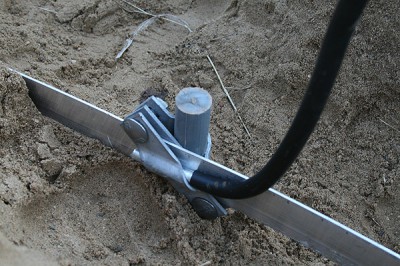
In a natural earthinger, the soil is installed (clogged, fall into the rounded wells) vertical elements interconnected by horizontal
In addition to the soil and water to the category of natural entrancers, metal pipes of water supply and other communications laid by trench manner include. Pipelines with combustible and explosive substances, highways built with partial use of PVC pipes and parts cannot be applied as earthing of natural origin. The designed to ensure the trouble-free functionality of electrical equipment in emergency and normal conditions, the working and protective ground, eliminating the likelihood of lesions, is mainly installed in the ground.
- Artificial earthingers presented most often with vertical or horizontal electrodes.
Method of calculating parameters
To perform calculations require the following data:
- characteristics of specific electrical equipment, such as the type of installation and its main devices, operating voltages, possible ways to carry out the grounding of neutrals of transforming and generating instruments;
- the size and configuration of the electrodes, which make it possible to take into account the estimated depth of their immersion in the ground;
- information about the measurement of the resistivity of the ground layer on the territory shutdown by the grounding system, the characteristics of a specific climate zone (obtain them can be in the local meteorological service);
Important. When placing a protective grounding system in two soil layers, data about the specific resistance of each of them is needed, the exact data on the power of the upper layer will be needed.
- information about the presence of suitable natural earthingers, which objects can be used for grounding, the real indicators of resistance to spread the current of these objects, obtained by measuring;
- accurate Earth Current Current Indicators standard method;
- the calculated characteristics of the values \u200b\u200ballowed by the norms and regulations, the period of action of grounding protection, which is necessary if the calculations were made by tension values \u200b\u200band by the values \u200b\u200bof the step voltage.
Preferably, the protective earth and the root of electrical installations are calculated for the installation of grounding system elements in a homogeneous soil. However, the methods of calculations with the location of the grounding in heterogeneous land are now developed and applied.
- The calculation of the entrancers located in a homogeneous environment requires accounting for the resistance values \u200b\u200bof a seasonally freezing layer during periods of freezing and drying the Earth. For accurate values, special coefficients used in settlements for grounding systems of any complexity are used.
- Calculation of earthing places installed in two or more soil layers requires accounting for the resistance values \u200b\u200bof all layers. The calculation is based on the accounting of all potentials induced to the installed electrodes included in the complex design from the grounding agents.
An independent calculation method is common for all schemes parameter - the required resistance determined in accordance with the regulations of the PEU.
For electrical equipment with a voltage of up to 1 kV, the resistance of the grounding element included in the system of protective grounding with an insulated neutral (type IT) is performed according to the condition:

In this inequality variable R. h is the value of the resistance of the grounding device (expressed in OM), constant value U. Pr.Dop. - the voltage parameter of contact (50 V), I. s - the total magnitude of the earth closure, expressed in A.
On regulatory requirements R. Z varies from 4 ohms to 10 ohms (the value of the lower limit does not provide special requirements, the upper is the maximum permissible parameter), provided that the power of the network and connected parallel to transformers and generators is not higher than 100 kVA.
To organize a protective grounding of higher-voltage settings in the calculations, other values \u200b\u200bare used:
- 0.5 ohms in power grids with effectively grounded neutral with large currents inherent in the land;
- not higher than 10 ohms at 250V voltage of contact in systems with an isolated neutral (condition is valid for small currents on the grounding object for equipment with a voltage of more than 1000 V).
Note. Preferred minimum resistance parameters of grounding contours. The smaller its value, the more effective there will be a current flow through objects with the least resistance.
Calculated for the installation of the grounding system to spread the current calculated for the earthing, during operation it may increase. Its value must be constantly monitored.
Scheme and installation circuit
IN apartment houses To protect tenants from lesions are established automatic switchesBarding (de-energization) electrical network In the event of a breakdown of isolation or closure.
In autonomous housing and at dachas, due to the lack of technical ability to install the disable automation, a protective grounding device is required, which can be done by contacting electricians, or made with your own hands.
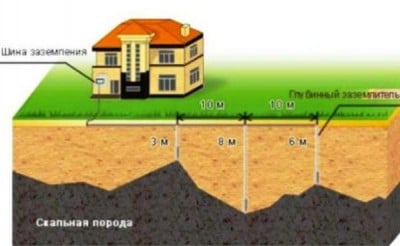
Linear scheme of the location of earthing workers shut away to rock soil
Grounding system without a depth eating
The elements of the contour, which does not include a deep earthing agent, can be installed in a row or located in the form of any geometric shape. The shape of the contour depends on the features of the site. This method is applicable at the length of grounding lines to 3 meters.
- Vertical entries are plunged. The distance between the machined vertically installed in the soil is calculated, based on the length of these parts of the grounding system. It is necessary to minimize the shielding, since the closer items are located, the more shielding effect.
- A phased measurement of the real values \u200b\u200bof the resistance of single earthingers are performed. They must be installed in an amount that ensures the formation of minimal resistance.
Note. Often for grounding equal in land area used miscellaneous number Grounding elements, since the resistance is influenced by the resistance of the soil.
- The connection of single earthing motors is performed. Grounders having an anti-corrosion coating are connected using special connectors. The grounding devices from ferrous metal are connected exclusively by welding, the seams are covered with bitumen mastic.

Connection with bolts is permissible only in the case of an anti-corrosion coating elements;
The attachment of the ground wire to the contour from the black metal is performed by welding with the subsequent fastening with a bolt
Group system with artificial entries
This is a simple, accessible for self-performing a protective grounding scheme with a circuit in the shape of an equilibrium triangle. This electric power supply system is located in a meter from the lower boundary of the base or wall.
- In accordance with the selected configuration, a trench of 0.8 meters depth is digging. The length of each side of the triangle is 3 m.
- In the vertices of the triangle, it is desirable to score well three meter depths. If it was decided to score vertical grounding of a sledgehammer, there will be a well-1.5 m wells.
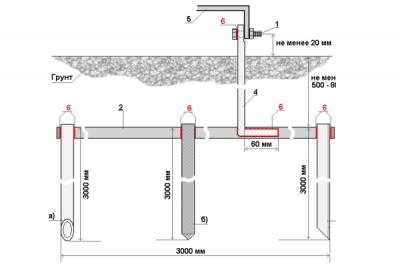
Scheme of the group contour of the protective ground
Note. It is much easier to score with pointed ends. Sharpen the grinder material that you are going to score.
As a material for vertical earthingers fit metal pipe With a diameter of 50 mm, a steel bar of 10 mm, a corner with a side of 50 mm. Three segments of three meters are required. The horizontal grounding element can be made of nine meters of a steel strip of 4mm thick, 40 mm width.
- Then the mounted grounding circuit is connected by welding with the conductor. It is made from a round rod or strip steel. It connects with a natural earthing.
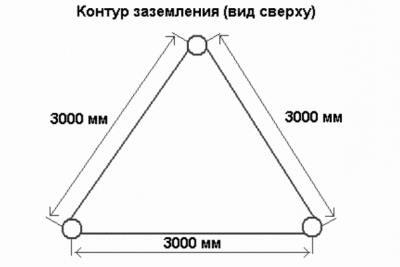
Plan of the location of the elements of the triangular contour of the protective ground
The mounted circuit successfully performs the purpose of the protective resistance, if it is connected to the steel water supply laid in the ground, to metal casing of water intake wells, to other w / b and metal designs. After installing the protective ground, all trenches and production must be filled with homogeneous soil without inclusions of rubble and construction waste.
Viewing a video clip will help to visually present the principle of operation and method of the device of the simplest grounding for country house:
Having received an idea of \u200b\u200bwhat is called a protective grounding, having learned about the methods of the device of the electric power system, you can easily begin independent installation. No need to forget about measuring the resistance size after installation. If there are no appropriate devices and skills, you need to call electricians.
Protective grounding- a deliberate electrical connection with the ground of metal inadvertent parts, which may be under voltage due to a closure on the body. Extraction of grounding is to eliminate the risk of electric shock in case of contact with the case.
The protective device is called the totality of the grounding and grounding conductors. The entrance is called a conductor or a set of metallically interconnected conductors who are in contact with the Earth .
Depending on the placement of the eating relative to the equipment, two types of grounding devices differ: remote and contour.
The remotely is characterized by the placement of the grounding outside the site, on which the equipment is placed or focused in the portion of this site. It is used in the installation up to 1000 V.
The contour is characterized by plating the electrodes along the contour of the site, on which the equipment is located.
Easers are distinguished by artificial, intended solely for grounding purposes and natural - metal-finding items in the ground. As artificial, vertical and horizontal are used. Vertical - steel pipes with a diameter of 5-6 cm or rod steel, with a diameter of at least 10 mm. To communicate vertical and as independent, strip steel with a cross section of 4 * 12 mm and the steel of the circular cross section with a diameter of at least 6 mm.
Earth operation depends on the type of soil, type and size of the conductor, climatic conditions.
48. Appointment and principle of protective reassembly
Stage - a deliberate electrical connection of metal inadvertent parts of electrical installations that can be under voltage with a deaf-free neutral. The conductor providing these connections is called a zero protective conductor.
The appointment of the rise is to eliminate the danger of damage to the current in the case of contacting the case. Principle of operation - transformation of the closure on the body into a short circuit in order to cause a high current capable of ensuring the protection of protection (fuses and so on) and automatically disable the damaged installation from the network. And reduces the voltage of the reassembled metal inadvertent parts.
49.Adnation and principle of protective shutdown
Protective disconnection It is called a security system that provides safety by turning off the emergency area or network as a whole when the hull circuit occurs on the case or directly to the ground, with the action time of not more than 0.1-0.2 s. The main elements of the protective shutdown are the protective disconnection device and the circuit breaker. The basic requirements are as follows:
High sensitivity - the ability to react to small changes;
Small time shutdown;
Selecting actions - selectivity - the ability to disconnect only damaged objects from the network;
The ability to carry out self-control of health;
Sufficient reliability is constant readiness for action.




